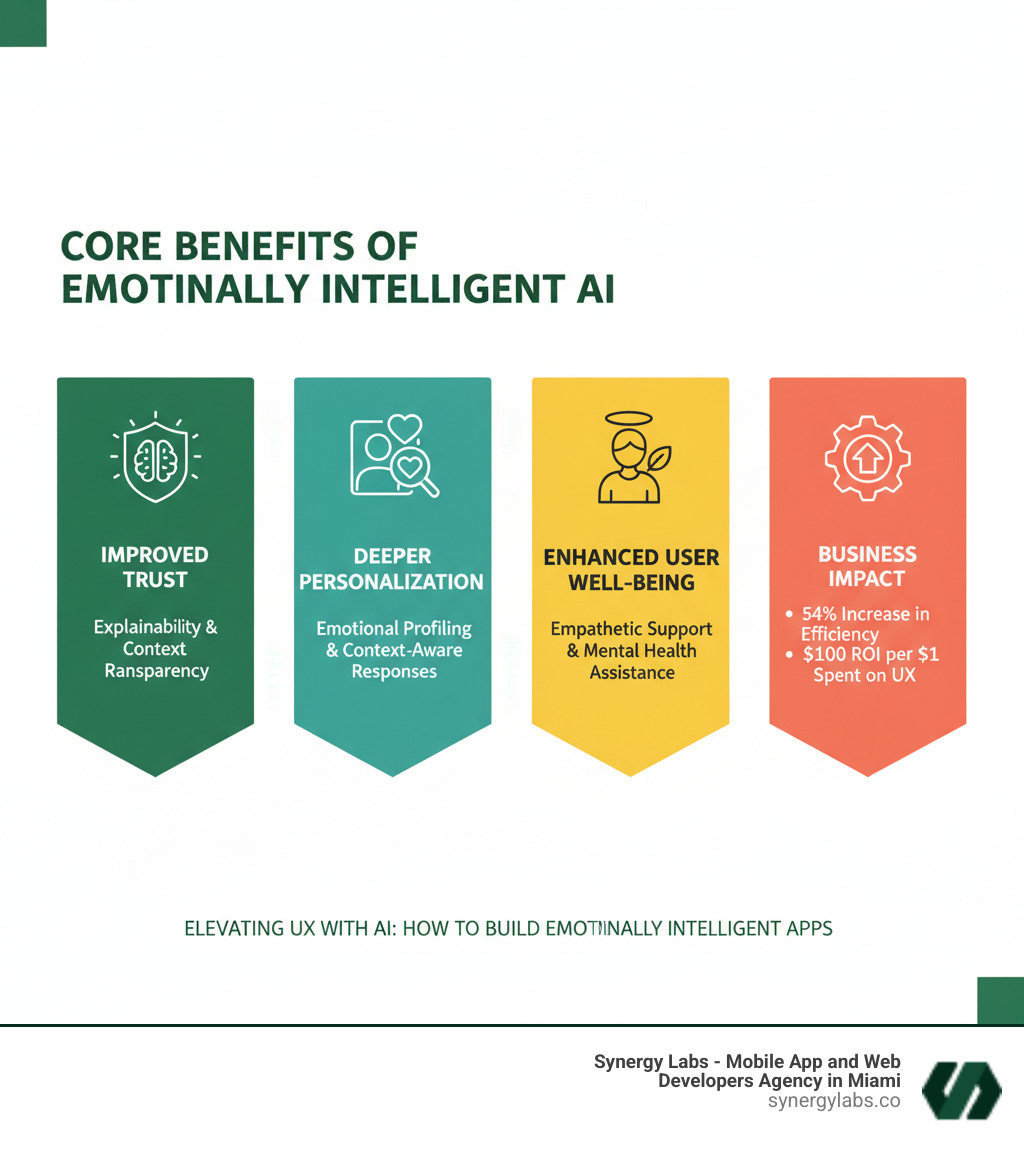Asóciese con una agencia TOP-TIER
Concierteuna reunión a través de este formulario y
le pondremos en contacto directamente con nuestro director de producto, sin vendedores de por medio.
¿Prefiere hablar ahora?
Llámenos al + 1 (645) 444 - 1069
"Designing applications that don't just respond to commands—they understand and adapt to human emotions in real time."

Elevating UX with AI: How to Build Emotionally Intelligent Apps is about designing applications that don't just respond to commands—they understand and adapt to human emotions in real time. This involves integrating emotional recognition technologies, designing adaptive responses, applying specific AI design patterns, building robust infrastructure, and prioritizing ethics with human oversight. The benefits are significant, including improved user trust, deeper personalization, and higher retention, with companies seeing a $100 return for every $1 spent on UX.
The shift from functional to feeling apps is driving massive growth in the AI market, projected to grow from nearly $100 billion to $2 trillion by 2030. This evolution is about bridging the empathy gap between humans and machines. While traditional apps force users to adapt to rigid interfaces, emotionally intelligent apps flip the script. They recognize frustration, adjust their language when you're stressed, and offer encouragement when you're struggling. Already, $54% of companies using AI report measurable increases in efficiency and engagement.
However, building these apps requires more than an AI model. It demands thoughtful UX, adaptive design, powerful infrastructure, and strong ethical guardrails. Done right, it transforms user interaction; done poorly, it feels creepy or manipulative. At Synergy Labs, we've seen how emotional intelligence boosts engagement and retention. This guide will show you how to build apps that don't just work—they care.

Think about the last time an app frustrated you. These moments reveal the gap between what technology does and what humans feel.
Emotional intelligence in AI-driven UX is about closing that gap. It refers to an AI system's ability to perceive, interpret, and respond to human emotions in a natural and supportive way. This isn't about creating machines that feel; it's about designing apps that recognize when you're stressed, confused, or delighted, and adjust their behavior accordingly. The technical term for this field is Affective Computing, which aims to bridge the empathy gap between humans and machines, creating emotional resonance that makes interactions feel more human.
The benefits are clear: users experience improved trust and loyalty, while businesses see better engagement. Integrating EI into AI means creating interfaces that respond to users' emotional states, not just their clicks. This is what Elevating UX with AI: How to Build Emotionally Intelligent Apps is all about—moving from functional to feeling.
So how does an app "read" your emotions? It's a sophisticated combination of technologies.
Natural language processing (NLP) and sentiment analysis form the foundation. Through advanced natural-language processing and sentiment analysis, AI detects the emotional tone in your words, distinguishing between resignation and genuine satisfaction. Modern models can even pick up on sarcasm, urgency, and confusion.
Voice tone analysis adds another layer, as AI systems can analyze users' tone of voice or phrasing and adjust their responses accordingly. A rising pitch might signal frustration, while a slower pace could indicate uncertainty. These vocal cues help AI respond with appropriate empathy.
Facial expression recognition takes it further. Using computer vision, AI can interpret universal facial expressions like a furrowed brow or a smile, providing valuable emotional context in video-based applications. By combining these inputs, AI builds a real-time picture of your emotional state, allowing for more nuanced and supportive interactions.
At Synergy Labs, we understand that integrating these capabilities requires thoughtful design. Our Mobile App Design Optimization services ensure these AI features blend seamlessly into user experiences.
The push toward emotionally intelligent AI solves real problems in digital interaction. For users, the advantages are immediate. Improved trust is key—when an app responds appropriately to your emotions, it builds a sense of being understood. Deeper personalization goes beyond preferences to tailor experiences to your current mood. The impact on mental well-being support is particularly powerful, as some apps offer empathetic, judgment-free conversations. This also leads to increased accessibility by adapting communication styles for diverse needs.
The business case is equally compelling. Research shows that 54% of companies leveraging AI experienced an increase in efficiency. But the real prize is engagement and retention. Given that 52% of users abandon brands after a bad mobile experience, emotionally intelligent apps reduce friction by adapting to user needs in real time. They don't just work better—they feel better. This feeling translates directly into higher retention, stronger loyalty, and improved brand perception, creating a lasting competitive advantage.
Building an emotionally intelligent app requires a human-centered design approach, a comprehensive AI development lifecycle, and seamless cross-disciplinary collaboration between UX designers, data scientists, and developers. Elevating UX with AI: How to Build Emotionally Intelligent Apps is about creating systems that genuinely understand and respond to the complexity of human emotion.

UX writing is your AI's voice. It's how your application connects with users on an emotional level. While AI can't feel, well-crafted writing can make it seem remarkably human. The foundation is clarity, which prevents frustration. Empathy transforms functional text into a meaningful connection by validating user feelings. The tone of your AI's voice must adapt to the user's emotional state, just as a friend would. Even microcopy—tooltips, error messages, and button labels—can provide reassurance or delight. Finally, storytelling builds a genuine connection, making interactions feel less transactional. This approach is even more powerful when you integrate behavioral science principles into your design process.
The magic of emotionally intelligent apps lies in their ability to become dynamic companions. Machine learning for personalization is the foundation, as AI’s ability to learn over time helps it understand user behaviors and motivations. This data feeds into user emotional profiles, allowing an app to anticipate needs, like offering a calming meditation on a stressful Monday morning.
Context-aware adaptation takes this further by considering when and where users interact. A late-night session or a noisy environment can influence mood, and the AI can adjust its response accordingly. This enables a shift from reactive to proactive AI, where the system anticipates needs instead of waiting for requests. As researchers have shown, we can enhance adaptive algorithms through the recognition of users’ emotions, turning reactive systems into proactive ones. For more on this, see our article on AI-powered Personalization.
When dealing with emotions, trust is everything. AI design patterns are essential tools for building user confidence. These are repeatable solutions to common challenges in AI-driven user experiences.
These patterns are critical as we move toward AI-native experiences, a topic we explore further in AI-Native UX: Why the Next Great Products Won't Look Like Apps.
Building emotionally intelligent apps requires a solid foundation that can handle the demands of real-time emotional analysis while respecting the responsibility of understanding human feelings. It's like building a bridge: you need both strong engineering and a commitment to safety.

Elevating UX with AI: How to Build Emotionally Intelligent Apps requires serious computing power. Analyzing voice, text, and facial expressions in real time is computationally intensive. This is why investing in servers with a graphics processing unit (GPU) is essential. GPUs excel at the parallel processing needed for modern machine learning models.
Beyond raw power, scalability for real-time processing is crucial. A delayed response from an emotionally intelligent app defeats its purpose. Your infrastructure must scale smoothly to handle user growth without lag. Finally, data management is non-negotiable. You are handling sensitive emotional data that requires secure, efficient pipelines to protect privacy while allowing the AI to learn.
With great power comes great responsibility. The line between manipulation versus persuasion is the first ethical hurdle. An app should guide users toward better experiences, not exploit emotional vulnerability for profit. As research notes, AI needs to provide choices rather than force unidirectional interactions. Maintaining user agency is paramount.
Data privacy and user consent are even more critical with emotional data. Crystal-clear transparency, explicit consent, and robust security are required to protect this personal information. We must also address algorithmic bias and fairness. AI models can perpetuate societal biases, leading to misinterpretation of emotions for certain demographics. Constant work is needed to identify and eliminate these biases. Ensuring user well-being must be at the heart of every decision.
The most effective emotionally intelligent AI systems are not fully autonomous; they are collaborations between machines and humans. Human-in-the-loop collaboration keeps UX designers and data scientists involved to provide intuition and ethical judgment. They guide the training and refinement of AI models, crafting the tone and defining boundaries.
Perhaps most importantly, we must make the human-AI handoff seamless for situations too complex for AI alone. A user in crisis may need to speak with a person, and the transition must be smooth. This blend of AI efficiency and human empathy is what makes an app great. It's not about replacing humans, but about giving them better tools to serve others. Learn more about our approach in From Good to Great: Elevating User Experience in Mobile Apps.
The shift from theory to practice is where emotional intelligence in AI truly shines. We're already seeing remarkable examples where emotionally aware apps are changing how people interact with technology. Understanding these Top 5 Trends in Mobile App Development helps us see where the industry is heading.
The future of Elevating UX with AI: How to Build Emotionally Intelligent Apps is moving toward understanding more sophisticated emotional nuance. The next generation of AI will likely be more proactive and ambient, anticipating needs and offering support seamlessly.
This progress brings challenges. Regulatory frameworks for data privacy and ethical AI use must evolve quickly. We must also balance helpfulness with the "creepy" factor, ensuring AI doesn't feel invasive. Maintaining transparency and user control over emotional data will be crucial.
Finally, there's the philosophical question of genuine empathy versus simulation. While the distinction may not matter to users if the experience is positive, as developers, we must remember we are creating systems that respond empathetically, not systems that are empathetic. This keeps us focused on user needs. At Synergy Labs, we are committed to implementing these principles responsibly, a topic we cover in The Importance of User Experience (UX) in Mobile App Design.
You're serious about Elevating UX with AI: How to Build Emotionally Intelligent Apps, but you may still have questions. Here are the most common ones.
Emotionally intelligent AI acts like a detective, gathering clues from multiple sources. It combines several technologies:
By combining these inputs, AI builds a comprehensive picture of a user's emotional state through large-scale pattern recognition.
Building technology that understands human emotions comes with significant responsibility. The key risks are:
Building these apps requires a strong ethical compass and constant vigilance to mitigate these risks.
No, not every app needs to be an emotional support companion.
Deep emotional intelligence is most valuable where the user's emotional state is integral to the experience. This includes mental health apps, customer service chatbots, personalized education platforms, and companionship bots. In these contexts, emotional awareness is core to the app's function.
However, for purely functional or transactional apps like calculators or weather apps, adding emotional intelligence would likely be overkill. For these, focusing on clarity, speed, and efficiency is more appropriate. The key is to understand your users' needs and the context of your app to determine if emotional intelligence would genuinely improve the experience.
We've reached the end of our journey, but in many ways, this is just the beginning. The future of user experience isn't just functional—it's empathetic, understanding, and deeply human.
Throughout this guide, we've explored how Elevating UX with AI: How to Build Emotionally Intelligent Apps requires three essential pillars: cutting-edge technology that can recognize and interpret human emotions, thoughtful human-centered design that translates those insights into meaningful interactions, and unwavering ethical principles that protect users while building trust. The goal has never been to create machines that actually feel emotions. Instead, it's about designing systems that understand and respect human feelings, creating experiences that resonate on a deeper level.
When done right, emotionally intelligent AI transforms everything. It builds trust through transparency and explainability. It enables personalization that goes beyond surface-level preferences to adapt to our moods and needs in real time. It supports mental well-being by offering empathetic responses when we need them most. And yes, it drives real business results—higher engagement, better retention, and meaningful ROI.
But here's the truth: building applications this sophisticated isn't something you can tackle alone. It demands expertise across multiple disciplines—AI development, machine learning, UX/UI design, behavioral psychology, and ethical AI practices. You need a partner who understands both the technical complexity and the human element.
At Synergy Labs, we've spent years perfecting this balance. As a top-tier mobile app development agency, we specialize in creating high-quality, scalable, cross-platform apps that don't just work—they connect. Our personalized approach means you get direct access to senior talent who genuinely care about your vision. We focus on rapid launches without sacrificing quality, ongoing support that evolves with your needs, and user-centered design that puts people first. And when it comes to emotionally intelligent AI, we bring the technical chops and the human touch needed to make it work.
The apps that will define the next decade won't just be smart—they'll be understanding. They'll recognize when you're frustrated and adapt their tone. They'll celebrate your wins and support you through challenges. They'll feel less like tools and more like trusted companions.
Ready to build something that truly connects with your users? Explore our services to see how we can help you build the next generation of emotionally intelligent applications. Let's create the future together.

Empezar es muy fácil. Póngase en contacto con nosotros compartiendo su idea a través de nuestro formulario de contacto. Uno de los miembros de nuestro equipo le responderá en el plazo de un día laborable por correo electrónico o teléfono para hablar de su proyecto en detalle. Estaremos encantados de ayudarle a hacer realidad su visión.
Elegir SynergyLabs significa asociarse con una agencia de desarrollo de aplicaciones móviles boutique de primer nivel que prioriza sus necesidades. Nuestro equipo con sede en Estados Unidos se dedica a la entrega de aplicaciones de alta calidad, escalables y multiplataforma de forma rápida y asequible. Nos centramos en el servicio personalizado, asegurándonos de que trabaje directamente con los mejores profesionales durante todo el proyecto. Nuestro compromiso con la innovación, la satisfacción del cliente, y la comunicación transparente nos diferencia de otras agencias. Con SynergyLabs, usted puede confiar en que su visión será llevada a la vida con experiencia y cuidado.
Normalmente lanzamos aplicaciones en un plazo de 6 a 8 semanas, dependiendo de la complejidad y las características de su proyecto. Nuestro ágil proceso de desarrollo garantiza que puedas lanzar tu aplicación al mercado rápidamente sin renunciar a un producto de alta calidad.
Nuestro método de desarrollo multiplataforma nos permite crear aplicaciones web y móviles simultáneamente. Esto significa que su aplicación móvil estará disponible tanto en iOS como en Android, lo que garantiza un amplio alcance y una experiencia de usuario fluida en todos los dispositivos. Nuestro enfoque le ayuda a ahorrar tiempo y recursos al tiempo que maximiza el potencial de su aplicación.
En SynergyLabs, utilizamos una variedad de lenguajes de programación y marcos para adaptarse mejor a las necesidades de su proyecto. Para el desarrollo multiplataforma, utilizamos Flutter o Flutterflow, lo que nos permite apoyar de manera eficiente web, Android y iOS con un solo código base, ideal para proyectos con presupuestos ajustados. Para aplicaciones nativas, empleamos Swift para iOS y Kotlin para aplicaciones Android.




Para las aplicaciones web, combinamos marcos de diseño frontales como Ant Design o Material Design con React. En el backend, solemos utilizar Laravel o Yii2 para proyectos monolíticos, y Node.js para arquitecturas sin servidor.






Además, podemos dar soporte a diversas tecnologías, como Microsoft Azure, Google Cloud, Firebase, Amazon Web Services (AWS), React Native, Docker, NGINX, Apache, etc. Este variado conjunto de habilidades nos permite ofrecer soluciones sólidas y escalables adaptadas a sus requisitos específicos.








La seguridad es una prioridad para nosotros. Aplicamos medidas de seguridad estándar del sector, como el cifrado de datos, prácticas de codificación seguras y auditorías de seguridad periódicas, para proteger tu aplicación y los datos de los usuarios.
Sí, ofrecemos asistencia, mantenimiento y actualizaciones continuas para su aplicación. Una vez finalizado el proyecto, recibirá hasta 4 semanas de mantenimiento gratuito para garantizar que todo funcione correctamente. Tras este periodo, te ofrecemos opciones flexibles de asistencia continua adaptadas a tus necesidades, para que puedas centrarte en hacer crecer tu negocio mientras nosotros nos encargamos del mantenimiento y las actualizaciones de tu aplicación.